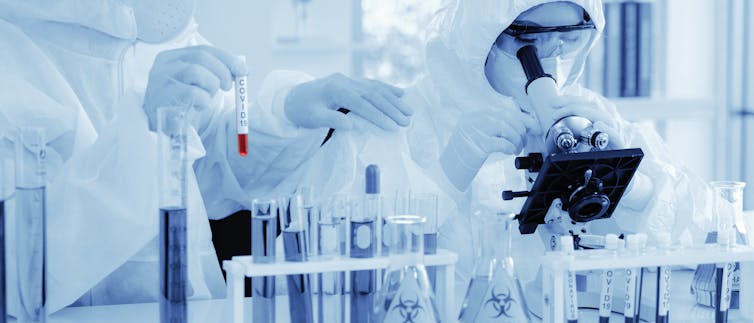Conspiracy theories may seem irrational – but they fulfill a basic human need
There has been a proliferation of conspiracy theories about COVID-19 that either reject the existence of the virus altogether or question the official account of its origins, its mode of transmission, its effects and its remedies. Many of these theories are highly implausible and harmful and it has become commonplace to describe them as irrational – even delusional.
But it is not plausible to describe them as signs of mental illness. Quite the opposite. Our research has shown that many irrational beliefs are attempts to protect mental health by responding to the human need for control, understanding and belonging.
The most radical theory about COVID-19 is denialism: the virus does not exist or is not as dangerous as is commonly believed. For some deniers, COVID-19 cannot be caught at all because germ-based transmission itself is a myth. For others, it is just a “common cold” and its alleged lethal effects are overplayed. Powerful individuals and organisations (such as Bill Gates or Big Pharma) are considered responsible for the hype, with motives ranging from making money to suppressing freedom.

Another popular theory denies that the virus passed from non-humans to humans accidentally. It was, instead, intentionally crafted by the Chinese in a lab in Wuhan. Other theories blame the quick and devastating proliferation of the virus on genetically modified crops or to the roll out of 5G technology.
All these theories share some common features. There is always some sort of murky plot that conflicts with official accounts, and they are usually based on limited or discredited evidence. But these common features are grounded in some basic needs that all humans share.
Seeking hope – and an explanation
Why do people fall for a plot? At the bottom, there is a powerful drive for causal understanding. In a novel situation, people need a causal map to navigate the environment. They may settle for an explanation before they have all the relevant information, because uncertainty is hard to tolerate. In a pandemic scenario, the explanation may be filling a gap caused by doubt and division among experts. This is definitely the case with COVID-19. Scientists have expressed disagreement about many aspects of COVID-19, from the severity of the threat to the effectiveness of face coverings (this is, of course, the process of scientific research).
As our previous research highlighted, people tend to prefer explanations that make reference to a person’s intentions over explanations that present the event as accidental. In particular, they tend to blame a threat on “agents” they may already have reason to distrust. This is why various COVID-19 conspiracy theories blame “the Chinese” who have long been political targets in Europe and the US, or pharmaceutical companies whose influence is criticised in the anti-vax and anti-psychiatry movements.
Seeing the event as planned rather than accidental allows people to maintain a sense of control over a reality that is confusing and unpredictable. If there is someone to blame, we can restore some kind of balance to the universe by seeking to punish the culprits for their evil conduct. Also, we can prevent them from harming us next time. This illusion of control contributes to our optimism about the future and helps us cope effectively with adversity.
Rejecting evidence
But why do people commit to a theory that is incompatible with accepted wisdom even when the evidence for it is inconclusive? The conflict with an official version arises from distrust towards institutions such as governments, scientists, the media and medical authorities. This distrust drives the belief in a conspiracy and is central to the identity of groups that people already associate with.
Conspiracy theories tend to originate within so-called “epistemic bubbles”. These are social structures in which opposing voices are, more or less deliberately, excluded. This typically happens in self-selected social media networks like Facebook groups or Twitter exchanges where those with a different view are blocked. Within these bubbles, theories about COVID-19 become something that defines who the people are and what they stand for.
Read more: Four experts investigate how the 5G coronavirus conspiracy theory began
Each bubble has its own standards to evaluate expertise and evidence. Some conspiracy theorists mistrust statistics and for some COVID-19 deniers the experts are not the epidemiologists, but the holistic health gurus. If people are trapped in an alternative bubble it may not be irrational (from their point of view) to endorse a theory that is consistent with their previous convictions and matches the testimony of others in their group. The theory is a way of imposing meaning on a constantly changing world.
This suggests that to counter the spread of conspiracy theories, we should find other ways to fulfil the needs from which they arise, such as the need for control or for causal understanding. Although we have no control over the fact that there is a pandemic, it can be empowering to realise that our behaviour in response to it – such as wearing a mask or respecting social distance – can make a difference to its outcomes. And although experts cannot always provide the unfaltering certainties people crave, friendly and accessible scientific communication can help debunk conspiracy theories and satisfy the human desire for knowledge and understanding.
*** This article has been archived for your research. The original version from The Conversation UK can be found here ***




